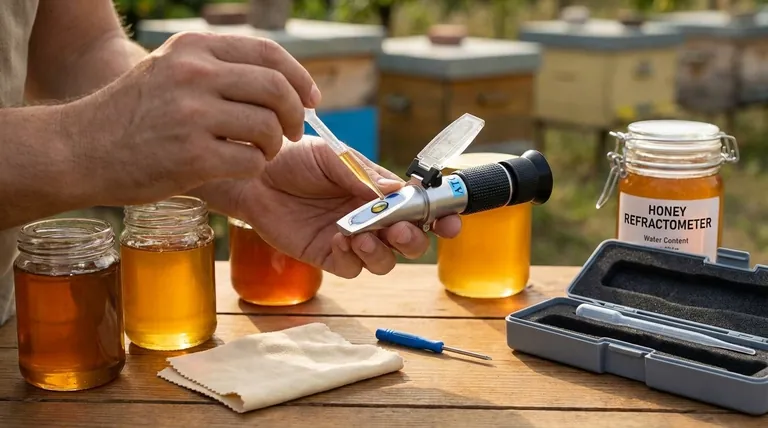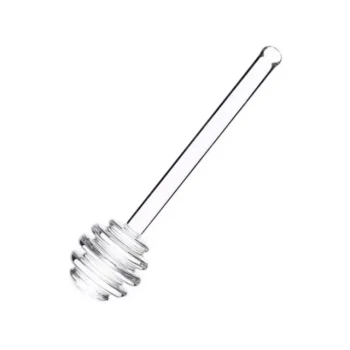To properly use a honey refractometer, the process hinges on four key actions: calibration before use, applying a small, temperature-matched sample of honey, taking a clear reading, and cleaning the instrument immediately afterward. These steps ensure you are measuring the water content accurately, which is the single most important factor in determining honey's stability and quality.
Your goal is not just to measure moisture, but to get a reliable measurement every single time. The accuracy of a refractometer depends less on the device itself and more on a repeatable process of calibration, temperature equalization, and meticulous cleaning.

Why Moisture Content is the Critical Metric
Understanding why you are measuring moisture content elevates the task from a simple chore to a critical quality control checkpoint. An incorrect reading can lead to significant problems.
Preventing Fermentation
Honey with a water content above approximately 20% is at risk of fermentation. Wild yeasts naturally present in honey can become active in this higher moisture environment, spoiling the entire batch and rendering it unusable for sale.
Ensuring Quality and Stability
Low moisture content is a hallmark of high-quality, fully cured honey. It is directly responsible for honey's thick viscosity and its legendary shelf stability. Accurate measurement confirms the honey is ready for extraction and bottling.
Meeting Commercial Standards
For commercial producers, honey must meet specific legal requirements. While this varies by region, most standards mandate a moisture content below 21% to be legally sold as honey, making accurate measurement essential for compliance.
The Step-by-Step Measurement Protocol
A consistent methodology removes guesswork and ensures your readings are dependable. Follow this protocol for every measurement.
Step 1: Calibration is Non-Negotiable
Before its first use of the day, you must calibrate the refractometer. This process sets the tool's baseline, ensuring the measurements that follow are accurate. Always follow the manufacturer's specific instructions for calibration.
Step 2: Temperature Equalization
For an accurate reading, the refractometer and the honey sample should be at the same ambient temperature. A significant temperature difference between the tool and the honey will skew the results.
Step 3: Proper Sample Application
Place a small drop of honey onto the glass prism. The goal is to use just enough to cover the surface completely once the daylight plate (the clear cover) is closed. Excess honey will squeeze out and create a mess.
Step 4: Remove Air Bubbles
After closing the daylight plate over the sample, you may see tiny air bubbles. Gently wiggling the plate can help remove them, as they can interfere with a clear reading.
Step 5: Reading the Scale
Hold the refractometer up to a natural light source and look through the eyepiece. You will see a scale with a distinct line separating a blue and white area. The point where this line crosses the scale indicates the honey's water content. Use the focusing ring to get a sharp view.
Step 6: Meticulous Post-Use Cleaning
Immediately after your reading, clean the prism and daylight plate with a soft, damp cloth. Allowing honey to dry on the glass will leave a residue that will corrupt all future measurements until it is completely removed.
Understanding the Trade-offs
The right tool depends on your specific needs. The most important feature to look for in any model is Automatic Temperature Compensation (ATC), which automatically corrects for ambient temperature changes, a crucial function for anyone working in non-laboratory conditions.
Analog Refractometers
These traditional models are often durable, require no batteries, and are very cost-effective. However, they rely on the user to interpret the scale correctly, which can introduce minor inconsistencies, and they require a good light source.
Digital Refractometers
Digital models provide a clear, unambiguous numerical readout, which minimizes user error and makes them faster to use. This convenience comes at a higher price, and they depend on batteries and can be more sensitive to rough handling.
Making the Right Choice for Your Goal
Your operational scale and primary objective should guide your decision and your process.
- If your primary focus is small-scale or hobbyist beekeeping: A durable analog refractometer with ATC provides the best balance of cost and reliable performance.
- If your primary focus is commercial production: A digital refractometer is a worthwhile investment to ensure consistent, rapid readings and minimize the risk of user error across a large volume.
- If your primary focus is absolute precision for compliance: Ensure your chosen device is regularly calibrated according to its manual and has a certified level of accuracy that meets your market's legal standards.
Mastering this simple tool is the most direct way to guarantee the quality and longevity of every honey harvest.
Summary Table:
| Key Step | Purpose | Critical Detail |
|---|---|---|
| Calibration | Sets an accurate baseline | Perform before first use each day |
| Temperature Equalization | Prevents skewed readings | Ensure device and honey are at room temperature |
| Sample Application | Covers prism for a clear reading | Use a small drop to avoid excess squeeze-out |
| Post-Use Cleaning | Prevents residue for future accuracy | Clean prism and plate immediately with a damp cloth |
Ensure the quality and compliance of every batch with the right equipment. HONESTBEE supplies durable, high-precision honey refractometers and other essential beekeeping supplies to commercial apiaries and distributors. Our wholesale-focused operations provide the reliable tools you need for accurate quality control. Contact our team today to discuss your equipment needs and secure your honey's quality.
Visual Guide

Related Products
- Precision Honey Refractometer Instrument for Quality Assessment
- Premium Heat-Resistant Glass Honey Dipper
- Honey Wax Separating Wax Press with Metal Screw Wax Separator Machine
- Inverted Squeezable Honey Jar with No Drip Flip Top Cap for Easy Pouring
- 10L Stainless Steel Electric Honey Press Machine
People Also Ask
- What are the benefits of using a Pocket Digital Honey Refractometer? Achieve Precision & Speed in Honey Quality Control
- What is a honey refractometer? The Essential Tool for Perfect Honey Quality
- What are the features of the Standard Refractometer for honey moisture content? Essential Tools for Quality Control
- What is a honey refractometer and what is its purpose? Ensure Honey Quality and Prevent Spoilage
- Why is a honey refractometer essential for honey harvesting? Protect Your Harvest from Spoilage



















